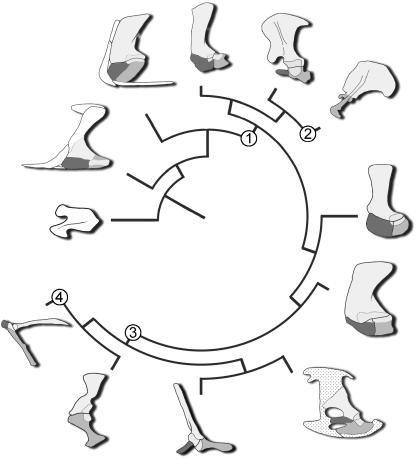Fig. 16.
Evolution of the amniote scapula, procoracoid and metacoracoid; a new scenario. Amniote phylogeny based on the work of Brochu (2001), Lee (1996), Luo et al. (2002), Rieppel & Reisz (1999) and Ruta et al. (2003). Beginning with the unified scapulocoracoid of †Eusthenopteron (far left, white) and continuing in a clockwise progression; †Acanthostega; †Seymouria; †Dimetrodon; Tachyglossus; Priodontes; †Scutosaurus; †Captorhinus; Shinisaurus; Macroclemys; Alligator; Sturnus. The phylogenetic arrangement follows the hypothesis of Testudines as diapsids; alternatively, Macroclemys could be positioned as the sister group to †Scutosaurus in accordance with the turtles as proganosaurs hypothesis (see text for details). Nodes: 1, delay in osteogenesis and/or the differentiation of skeletogenic cells results in the formation of sutures and the discrete development of each of the scapula, procoracoid and metacoracoid; 2, integration of the procoracoid rudiment into the sternum combined with reduction in preskeletogenic cell proliferation of each of the procoracoid and metacoracoid rudiments results in the scapula dominating the primary girdle; 3, reduction of preskeletogenic cell mitosis and accelerated osteogenesis of the procoracoid condensation results in this element remaining linked with the scapula, albeit as a vestige; 4, delay in procoracoid osteogenesis and/or reaggregation of the procoracoid condensation alongside the presumptive metacoracoid results in coalescence of the two elements. See text for details. Glenoid shaded, cartilage stippled, scapula yellow, procoracoid red, metacoracoid blue. For sources of images please see Fig. 4. Not to scale.

